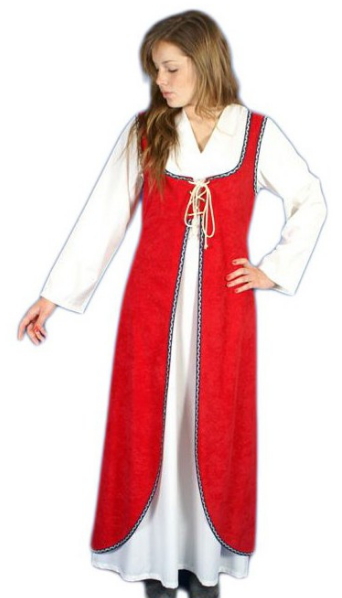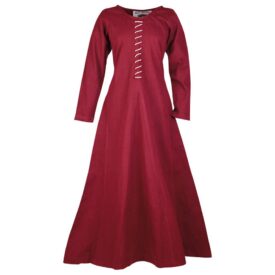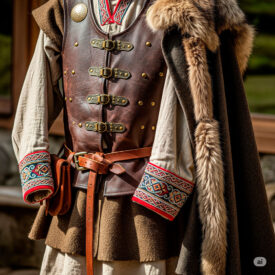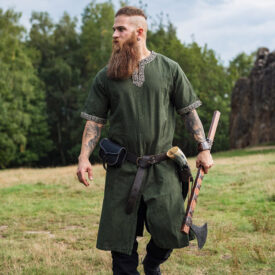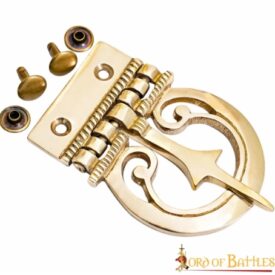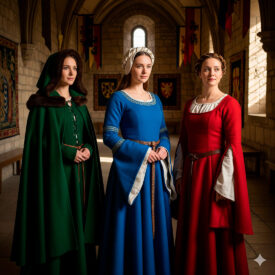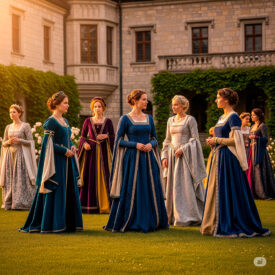The brial, an iconic garment of medieval women’s clothing, is much more than just a dress. It is a fascinating canvas that tells us about the society, values, and creativity of past eras. Often, the popular perception of the brial is far from its historical reality, so today we will delve into its deepest details, from its construction to its social significance, based on the most rigorous studies.
What Exactly Was the Brial? Definition and Historical Evolution
The term “brial” has its roots in the French “bliaut” of the 12th century. Originally, the 12th-century women’s bliaut was described as a dress with a round neckline, often adorned with embroidery. Its sleeves were fitted to the elbow, then flared out in a bell shape, becoming extremely wide at the wrist. The skirt was long, reaching the floor. A distinctive feature was how it fit the body: it was tied at the sides, creating a gathered effect in the midsection.
It is important to note that there were significant variations in bliauts between different countries and even within representations in French cathedrals. Over time, the concept of the brial evolved, adapting to the fashions of the 13th, 14th, and 15th centuries, periods for which it is suitable in modern reenactments.
There is some ambiguity in the sources as to whether the brial was an undergarment or outerwear. Some descriptions define it as an outer garment, similar to a basic dress but richer in fabrics and with more fullness and fabric. However, other sources categorize it as an “undergarment” or indicate that it could be both an inner and outer garment.
During the Reconquista, especially from the 11th century onward, two or three overlapping pieces were worn as tunics (the tunic and the loba or sleeveless sayo, in addition to the shirt), with the uppermost piece usually being the brial, a fitted-sleeve garment whose cuffs and neckline were decorated with geometric or spiral embroidery.
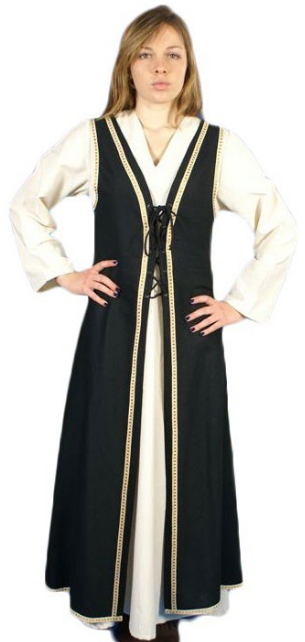
For women, the brial was a long garment that would trail on the ground. It was fastened with a cord, fitting the body from below the bust and opening into panels at the sides. There were also printed designs covering the entire garment.
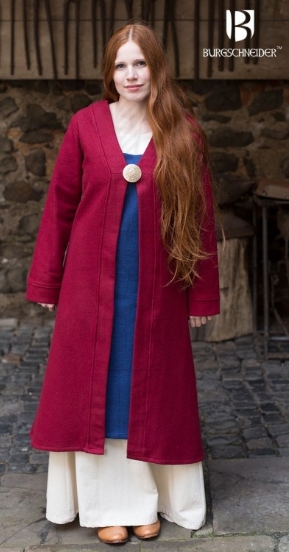
Materials and Colors: A Reflection of Status and Economy
The choice of materials and colors for a brial was no coincidence; it was a clear indicator of the social status and purchasing power of the wearer. Brials intended for the nobility were made with rich and luxurious fabrics, such as ciclaton and samite. They could also be made from various fabrics such as cotton, woolen cloth, linen, or silk. The use of silk was especially popular and was attributed with great durability. In Catalonia, wool production was predominant, although there were important trade connections with silk centers like Genoa via Barcelona.
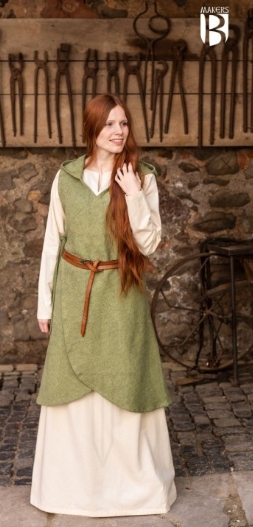
As for colors, brials were offered in shades such as brown, blue, green, garnet, ochre, and mustard. Medieval moralists, such as Francesc Eiximenis, often criticized luxury in dress, including the use of jewelry and expensive colors, reflecting their symbolic importance. Interestingly, black became the color of widows in Catalonia, and any excuse was sought to wear it, even for mourning distant relatives.
Furs were also an element of luxury and status. Ermine was the most used fur in the 15th century and is frequently mentioned in documents and novels of the time. Other furs, such as otter, though popular in other parts of Europe, hardly appear in Catalan documentation.
The Brial in Medieval Society: Hidden Messages and Female Roles
Clothing in the Middle Ages was not just a matter of dressing; it was a non-verbal language, a “book of semiology and symbols” that revealed the mindset, values, and morality of the era.
Noblewomen, in particular, had to appear “perfectly groomed” in public, alongside their family and attendants, to properly represent their lineage. This quest for ostentation by the nobility often competed with the emerging bourgeoisie, who also sought to display their wealth through their attire.
Medieval women were intrinsically linked to textile work. It is known that, under the direction of the lord’s wife, women worked weaving or preparing high-quality fibers such as silks, gold, and pearls in what was known as the “gynaeceum.” However, it is difficult to determine whether these homemade productions were solely for personal use or also for sale.
The “Querelle des femmes,” a philosophical movement of the 15th century, even saw authors like Christine de Pizan defend women’s right to dress and use clothing as a form of personal expression. However, society and moralists maintained a strict view. Francesc Eiximenis, for example, devoted entire chapters of his works to dictating how women should dress, criticizing pride and vanity, and even mentioning the frequent use of makeup and care with jewelry. The “alfarda,” a garment to reduce or cover the neckline, is mentioned as an element that could be both practical and ornamental.
The mantle, a luxurious and practical garment, was a common complement to the brial, used by both men and women. It was often made with rich fabrics and lined with fur, such as ermine.
It is important to note that representations of medieval fashion in modern fiction, such as historical novels, often transfer contemporary ideas and values about female freedom and sexuality to past eras, which can create anachronisms and a distorted view of historical reality. While these works may strive to reconstruct material details, they often fail to reflect the mental structures and complex social codes of the time.
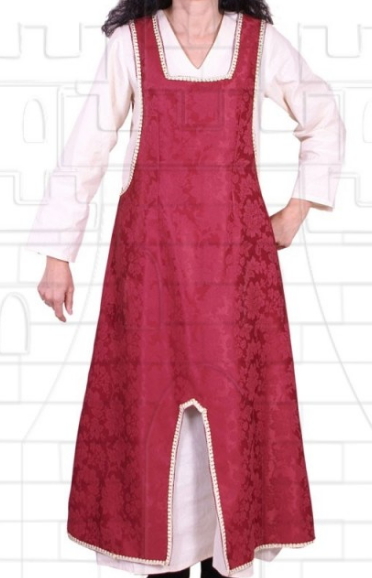
The skirts (which for some constitute the true brial, as has been said for men-at-arms) were notably reduced or eliminated from the mid-15th century, leaving only the upper body or doublet alone or with small skirts, then combined with full hose.
The Brial in Historical Reenactment: From Research to Detail
For those interested in historical reenactment, the medieval women’s brial is a fundamental piece. Specialized guides and rigorous documentation are key to dressing properly and faithfully. Making an authentic brial requires specifying design preferences and, crucially, exact measurements.
It is vital to recognize that what is commonly sold today as a “brial” in online stores may differ significantly from the historical 12th-century “bliaut.” In fact, some modern versions resemble certain Italian Renaissance dresses more than the original medieval brial. Ongoing research into medieval clothing is essential, as, although sometimes considered a minor field, it is rich in information to discover and allows for dating works of art by providing a visual understanding of an era.
Ultimately, the medieval brial is much more than a garment. It is a window into the complex and fascinating reality of the Middle Ages, a reminder of how fashion was (and still is) a mirror of society and its constant transformations. If you are looking to acquire a brial or any other piece of medieval clothing for reenactment, theater, or simply to collect, be sure to visit specialized stores that offer faithful and quality replicas.
